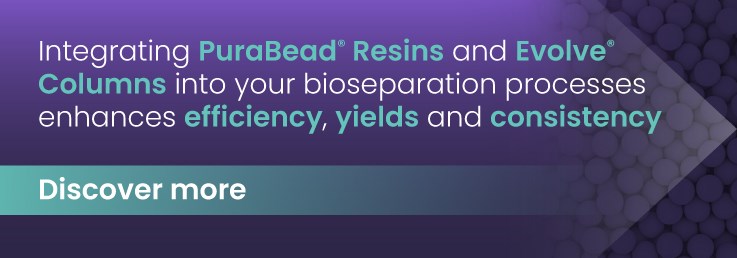Host Cell Protein Removal
Host cell proteins (HCPs) encompass all the soluble proteins produced by cells, in addition to the intended biopharmaceutical product. Depending on the expression system, HCPs can exist in very high concentrations, necessitating extensive purification processes for their removal. The presence of HCPs in pharmaceutical products raises concerns due to the potential for adverse reactions, requiring their reduction to minimal levels. This process can be challenging, especially when HCPs are closely associated with the target biopharmaceutical or share similar macroscopic properties such as size, polarity, or isoelectric point. Typically, the removal of residual HCPs involves the use of mixed-mode ligands that combine strong hydrophobic and either strong anionic or cationic regions. However, these resins often bind both the target product and the HCPs, complicating the purification process.
HCP removal with HCPure™
HCPure™ is a new type of mixed-mode ligand, specially designed for capturing host cell proteins (HCPs). It features mildly hydrophobic groups and polar groups that interact with proteins through a combination of hydrophobic and electrostatic interactions. Chosen from Astrea Bioseparations’ Chemical Combinatorial Library®, HCPure™ effectively binds a broad spectrum of host cell proteins from various sources, including bacterial and mammalian cells like CHO, HEK293, and
E. coli, with minimal binding of critical target biological compounds such as monoclonal antibodies and viral vectors. Built on the PuraBead® 6HF base matrix, HCPure™ is fully alkali stable, allowing for cleaning and sanitization with 0.5M or 1M NaOH, and supports high flow rates, low back pressures, and extended operational lifetimes. HCPure™ is ideally suited as a polishing step for a broad array of biopharmaceutical products, particularly where HCPs are challenging to remove, or traditional mixed-mode resins fall short.
Shop the Range Polishing to remove residual HCPs using PuraBead® IEX
Ion Exchange (IEX) chromatography is a critical polishing step following Protein A capture, effectively targeting the capture and elimination of product-related impurities and host cell proteins. At Astrea Bioseparations, we offer a robust lineup of fully alkali-stable ion exchange resins. These resins, based on the free-flowing, near-monodisperse PuraBead® 6HF base matrix, deliver high binding capacities, extended operational lifetimes, high flow rates, and low back pressures. Choosing the ideal PuraBead® ion exchange resin and chromatography buffers for your specific needs is streamlined with our user-friendly pre-packed RoboColumns® and IEX Selection Kits, ensuring consistent, high-quality results in the purification of antibodies.
Shop the Range
Removing residual HCPs with PuraBead® HIC
Hydrophobic Interaction Chromatography (HIC) is widely used as a polishing step to remove product-related impurities and host cell proteins. At Astrea Bioseparations, we offer an extensive selection of robust, fully alkali-stable hydrophobic interaction resins. These resins are based on the free-flowing, near-monodisperse
PuraBead® 6HF base matrix, providing high binding capacities, extended operational lifetimes, high flow rates, and low back pressures. Selecting the perfect
PuraBead® HIC resin and chromatography buffers for your specific application is streamlined with our pre-packed
RoboColumns® and IEX Selection Kits, ideal for consistently achieving high yields of highly purified biopharmaceutical products.
Shop the Range







